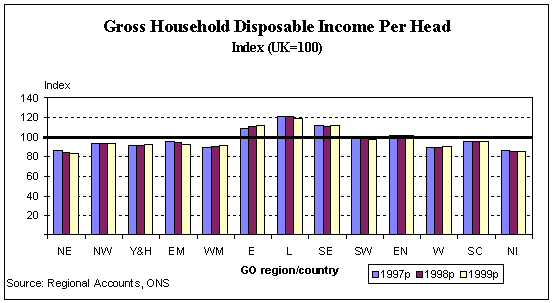| Section 1: Overall
Competitiveness
1. Gross Value Added and Household Disposable Income per Head Gross Value Added and Household Sector Disposable Income measure different aspects of a region’s income. GVA gives an indication of the value of the economic activity generated within an area, whilst Household Sector income provides an indication of the income received by resident households and non-profit organisations which serve households. Since the last publication of the Regional Competitiveness Indicators in March 2001, the statistic previously termed 'Gross Domestic Product' has been renamed as ‘Gross Value Added’ (GVA). The change of title makes the terminology consistent with the latest European accounting framework. Refer to the Definitions Section (Annex I) for a description of these and other changes. GVA per Head This is an important indicator of the economic activity generated within a region compared with the region's resident population, and shows changes over time. These figures have been taken from the regional economic accounts produced by the Office for National Statistics (ONS). The latest available statistics at regional level are for 1999. The statistics indicate that, since 1989, London has consistently been the region with the highest relative GVA, at between 142% and 148% (UK = 100). In 1999 the English region with the lowest relative GVA was the North East (77.3%) while the figure for Northern Ireland was similar (77.5%). GVA per Hour Worked Introduced for the first time in this edition of Regional Competitiveness Indicators, these statistics overcome one of the difficulties of GVA per head of population as an indicator. This is that the statistic of GVA generated within the region (including wages) is generally workplace based, while the population estimate is based on residents within the region. Thus commuting significantly effects the statistics and regions with a high level of inward commuting, such as London, will have an artificially high GVA per head. In Table 1(b) GVA is presented relative to the number of hours worked in the region, rather than in terms of per head of population resident. London, at 116.7% in 1999, remains higher than the average (UK=100) but the differences between regions are not as marked as for GVA and HDI per head. The lowest figure for GVA per hour worked, relative to the UK as a whole, in 1999 was for Northern Ireland, at 83.5%. The lowest figure for an English region was recorded for the West Midlands, at 90.3% with the South West next at 90.4%. Gross Household Disposable Income per Head Disposable Household Sector income is defined as total household income (including benefits) less current taxes on income and wealth and other social contributions such as National Insurance and payments into life assurance and pension funds. While GVA gives an indication of the value of all economic activity in a given area, Household Disposable Income (HDI) is indicative of the income households within regions have to spend on goods and services. In 1999 disposable household income per head of resident population in London was around one fifth greater than for the UK as a whole. It was substantially lower than the UK average in the North East (17% lower) and Northern Ireland (14% lower). Since 1990, disposable household income per head in London, the South East and East have been consistently above the UK average.
Chart
1(a)
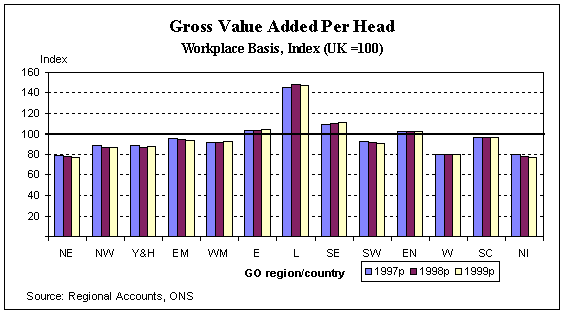
Chart 1(b)
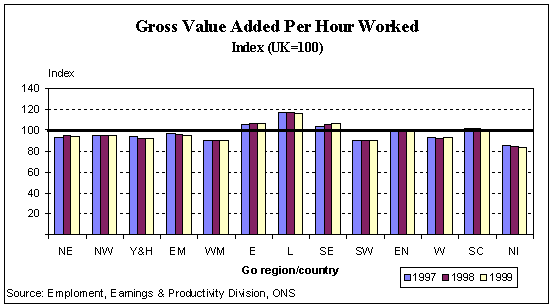
Chart
1(c)
2.
Labour Productivity in Manufacturing
and Other Industries
This is used as an indicator of competitiveness within the manufacturing and other sectors (including services, mining, electricity and gas supply, but not agriculture, forestry and fishing). Tables 2(a) and 2(b) are calculated as GVA per employee. Although GVA per employee in manufacturing grew in all regions between 1995 and 1998, in most regions overall growth was either in line with, or below Retail Price Index (RPI) inflation, which was 11% over this period. The other sectors have fared better, showing some growth above the RPI level between these years. It is important to consider the value of these indicators in the context of the mix of industries between regions. Some industries are highly labour intensive and so may have relatively low employee productivity figures when compared with more capital intensive industries. Chart 2 illustrates, the value of GVA per employee
for the manufacturing and other sectors
respectively in the UK regions during 1998.
Chart 2
 The number of Income Support Claimants is used as an indicator of social deprivation. Table 3(a) shows the number of Income Support Claimants as a proportion of the population over 16 years of age for quarters between 1997 and 2001. Tables 3(b) to 3(e) break down the receipt of Income Support benefits by broad client group, namely; pensioners, disabled, lone parents and 'other' recipients. Since the introduction of the Jobseeker’s Allowance (JSA) in October 1996, claimants of unemployment - related benefits are no longer included in the Income Support figures. Estimates of both Claimant Count and the ILO unemployment can be found in Indicator 8. As a proportion of the adult population, in May 2001 Northern Ireland had the highest percentage of claimants in any UK region / country for each of the benefit categories with the exception of lone parent benefits. After Northern Ireland, the North East had the highest proportion of pensioner income support claimants. The North East, North West and Wales all had the second highest proportions who were disabled claimants whilst London had the highest percentage of lone parent benefit claimants.
Chart 3
 4. Manufacturing Investment and Output by UK and Foreign Owned Companies This series is used as an indicator of the attractiveness of a region to foreign investors and, the importance of foreign investment to the manufacturing base of a region. Tables 4(a) and 4(b) show the trends in the figures for the investment and output (measured by GVA) by both foreign and UK-owned companies. In 1997 approximately £20 billion was invested in the UK, and around a third was from foreign-owned companies. Investment is measured by Net Capital Expenditure. The estimates for Individual years should be treated with caution as large one-off investment decisions by companies can make significant differences to total investment figures in a particular region and year. To help overcome this, Chart 4 shows the average percentage of manufacturing investment from foreign-owned companies for the years 1994 to 1997 combined. This indicator only covers investment in manufacturing businesses within the UK. The latest available data, currently, is for 1997.
Chart 4

5.
Exports of Goods
Chart 5(a) illustrates the regional shares of total UK exports of goods for quarters between Autumn 2000 and Spring 2001. It should be noted that the value of exports produced is dependent on the size of the region's economy. In addition to this, the production of some goods (for example motor vehicles) can involve several separate stages that may take place across more than one region. Comparisons between regions should be interpreted with care because the value added of an export product may have been generated in areas other than the region from which the item was exported. Chart 5(b) details the value of exports for the years 1999 and 2000 per employee job within each region. During 2000, the East of England had the highest value of exports per employee job, followed closely by Scotland. Regional Export data do not cover the exports of services at present, so it is important to take account of a region’s industrial profile when interpreting these figures. Regions which have a high concentration of service sector employees are likely to have a lower level of exports of goods per total employee jobs than regions with more manufacturing employment. Table 5(a) provides the value of exports from each region for all quarters between 1999 and the first quarter of 2001 as well as the totals for the 1999 and 2000 expressed as a value per employee job. Table 5(b) gives the number of companies within each region exporting within the European Union (EU) and outside the EU for all quarters during 1999 and 2000. Companies who export to both EU countries and the rest of the world will appear more than once in the company count, that is, in both parts of table 5(b). Table 5 (c) shows proportions of exports of goods to the main world regions. During 2000 around 75% of total UK exports were to either the EU or North America with exports to the EU accounting for the majority of these.
Chart 5(a)
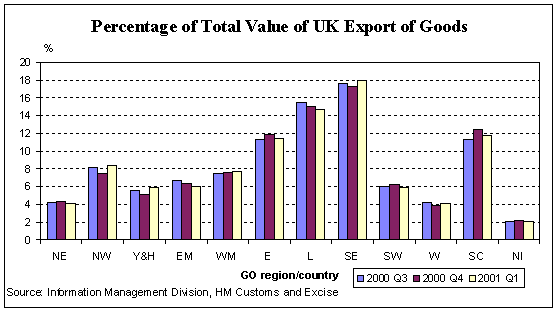
Chart 5(b)
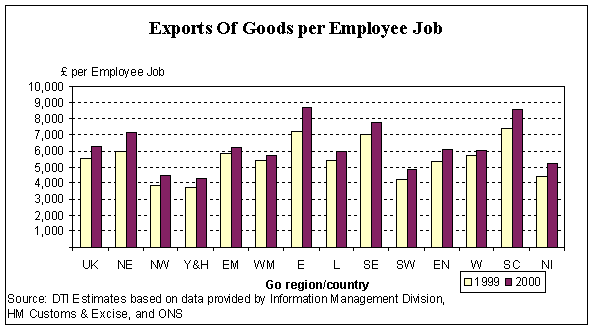
Home - Search - Site Map - Contact Us |
